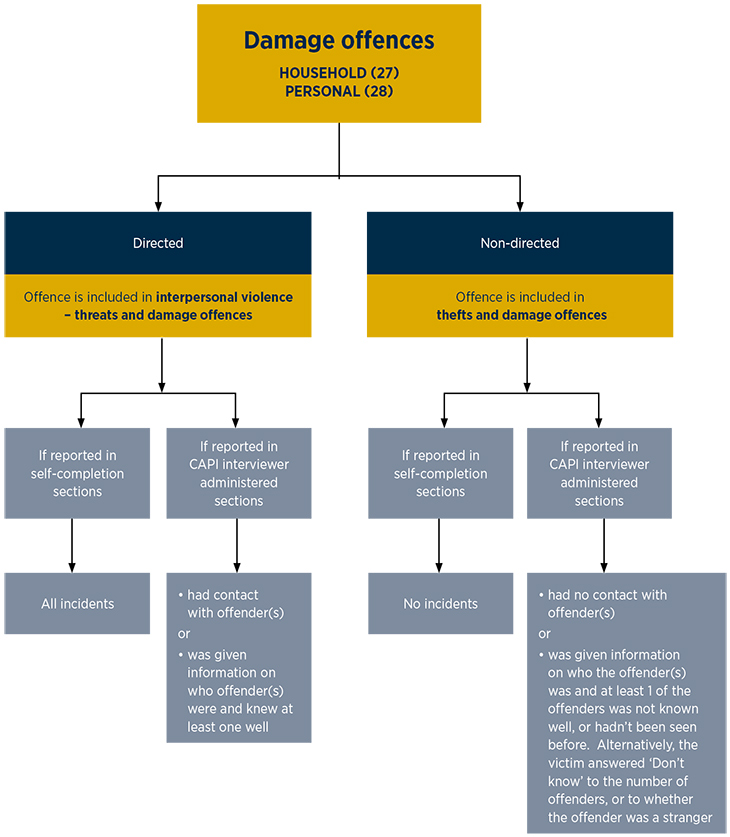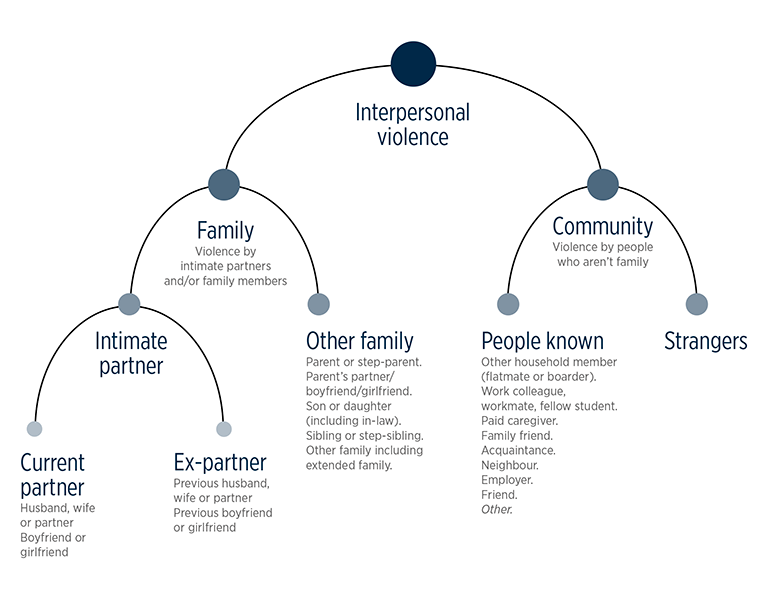Classifications & groupings
This page gives information about the classifications and groupings used in the reporting for the New Zealand Crime and Safety Survey (NZCASS).
For more detail, see the NZCASS Technical manual [PDF, 5.3 MB]
Demographic and geographic classifications
A statistical classification is a way to group a set of related categories in a meaningful, systematic and standard format.
In 2014, a review of the classifications used on demographic and geographic measures was conducted to bring new and existing demographic and geographic measures in line with NZ Statistics standard classifications where possible.
The following table shows the demographic and geographic classifications used in NZCASS reporting, along with the sample sizes for each category.
| Data item | Categories | Sample size (2014) |
|---|---|---|
| Personal factors | ||
| Sex | Male | 3,059 |
| Female | 3,884 | |
| Age | 15-19 Years | 380 |
| 20-29 Years | 924 | |
| 30-39 Years | 1,061 | |
| 40-49 Years | 1,297 | |
| 50-59 Years | 1,174 | |
| 60-64 Years | 541 | |
| 65 Years and over | 1,560 | |
| Ethnicity | European | 4,932 |
| Māori | 2,384 | |
| Pacific Peoples | 314 | |
| Asian | 466 | |
| Other ethnicity | 94 | |
| Legally registered relationship status | Married/Civil union (not separated) | 2,985 |
| Separated/Dissolved | 995 | |
| Widowed/Surviving partner | 602 | |
| Never married and never in a civil union | 2,339 | |
| Partnership status | Partnered | |
| Legally registered | 2,897 | |
| Not legally registered | 1,171 | |
| Non-partnered | 2,727 | |
| Economic factors | ||
| Employment status | Employed | 4,011 |
| Unemployed | 244 | |
| Not in the Labour Force | ||
| Retired | 1,394 | |
| Home or caring duties | 481 | |
| Studying | 436 | |
| Not actively seeking work / unable to work | 334 | |
| Financial stress: Limited to buy item for $300 | Not at all limited | 3,087 |
| A little / quite limited | 1,846 | |
| Very limited / couldn’t buy it | 1,973 | |
| Financial stress: Can meet unexpected expense | Yes | 5,321 |
| No | 1,558 | |
| NZ Deprivation Index | Quintile 1 (Least deprived) | 1,162 |
| Quintile 2 | 1,246 | |
| Quintile 3 | 1,446 | |
| Quintile 4 | 1,438 | |
| Quintile 5 (Most deprived) | 1,633 | |
| Personal income | $30,000 or less | 2,968 |
| $30,001-$70,000 | 2,314 | |
| $70,001 or more | 909 | |
| Don’t know / Refused | 752 | |
| Household income | $30,000 or less | 1,280 |
| $30,001-$70,000 | 1,959 | |
| $70,001-$100,000 | 922 | |
| $100,001 or more | 1,410 | |
| Don’t know / refused | 1,372 | |
| Household factors | ||
| Household composition | One person household | 1,518 |
| One parent with child(ren) | 643 | |
| One parent with child(ren) and other person(s) | 198 | |
| Couple only | 1,838 | |
| Couple with no children and other person(s) | 130 | |
| Couple with child(ren) | 1,693 | |
| Couple with child(ren) and other person(s) | 168 | |
| Multiple family household | 177 | |
| Other multi-person household | 330 | |
| Tenure and landlord type | Owned (including with a mortgage) | 4,561 |
| Rented – Private | 1,848 | |
| Rented – Government (local and central) | 448 | |
| Geographic factors | ||
| Urbanisation | Main urban area | 4,778 |
| Secondary urban area | 447 | |
| Minor urban area | 763 | |
| Rural | 955 | |
| Region | Auckland | 1,880 |
| Wellington | 739 | |
| Rest of North Island | 2,790 | |
| Canterbury | 788 | |
| Rest of South Island | 746 | |
| Total respondents | 6,943 | |
Household composition
The following table provides descriptions of each household grouping:
| Composition grouping | Description |
|---|---|
| One-person household | Lives alone. |
| One parent with child(ren) | One person living with their son(s) and/or daughter(s) (natural, step, adopted or foster). |
| One parent with child(ren) and other person(s) | This household could include another person that is unrelated, such as a flatmate or boarder or could be related but not part of the immediate family unit, such as parent’s sibling/children’s aunt. |
| Couple only | Two persons who are either opposite-sex or same-sex spouses / civil union partners / partners. |
| Couple with no children and other person(s) | This household could include another person, such as a flatmate, boarder or a family member, such as a parent of one couple member. |
| Couple with children | Two persons who are either opposite-sex or same-sex spouses / civil union partners / partners, living with their son(s) and/or daughter(s) (natural, step, adopted or foster). |
| Couple with children and other person(s) | This household could include another person that is unrelated, such as a flatmate or boarder or could be related but not part of the immediate family unit, such as parent’s sibling/children’s aunt. |
| Multiple family household | This is when multiple families are living in the same household for example. two married couples flatting together or a married couple plus one partner’s mother and father (which is considered a second family unit). |
| Other multi-person household | This comprises of households of related and / or unrelated people, where there is no couples, or parents with a child. It consists for example of flatting arrangements, two siblings living together or one person with a boarder. |
Note: The terminology of ‘children’ can relate to young children or adult children, but are defined to be children if they do not have their own partners nor children of their own living in the household.
Offence groupings
Offences are grouped together in different ways for different purposes. In 2014, we reviewed how offences were grouped to:
- make sure offences were grouped consistently in all the reports
- make sure a large enough sample was available in each grouping (where possible)
- better meet the research objectives and stakeholder information needs.
The table below shows the standard set of five offence groupings used throughout NZCASS reporting (the associated offence codes are in brackets).
| GROUPING 1 All offences – detailed | GROUPING 2 All offences – broad | GROUPING 3 Type of violence | GROUPING 4 (subset of grouping 5) Comparisons with Police data | GROUPING 5 All offences – reporting to Police | |
|---|---|---|---|---|---|
| Personal offences | Sexual offences (1, 2, 4) | Violent interpersonal offences by relationship to offender | Sexual offences (1, 2, 4) | Sexual offences (1, 2, 4) | |
| Threat – of force (21) | Threats and damage offences | Threats (21, 29) | |||
| Threat – to damage property (29) | |||||
| Damage – personal property (28) | Damage/theft – personal property (18, 28) | ||||
| Assault (6, 7, 8) | |||||
| Robbery (9) | Physical offences (6, 7, 8, 9) | Assault (6, 7, 8) | Assault (6,7,8) | ||
| Theft – from the person (10) | Thefts and damage offences | Robbery/theft – from the person (9, 10) | Robbery/theft – from the person (9, 10) | ||
| Theft – personal property (18) | *Damage/theft – personal property (18, 28) | ||||
| *Damage/theft – personal property (18, 28) | |||||
| Household offences | Theft – household property (12, 13, 17) | Damage/theft – household property (12, 13, 17, 19, 27) | |||
| Damage – household property (19, 27) | |||||
| Burglary (11, 41) | Burglary (11, 41) | Burglary (11, 41) | Burglary (11, 41) | ||
| Theft – vehicle (14) | Vehicle offences (14, 15, 16, 26) | Theft – vehicle (14) | Theft – vehicle (14) | ||
| Damage – vehicle (26) | Damage – vehicle (26) | ||||
| Thefts – from vehicle/vehicle interference (15, 16) | Thefts – from vehicle/vehicle interference (15, 16) | Thefts – from vehicle/vehicle interference (15, 16) |
Damage offences
Personal or household damage offences are set out as follows:

Primary and secondary offences
In some cases, more than one offence might occur in the same incident. For example, someone might have been both kidnapped and sexually violated in the same incident. In this case two offences would be coded, abduction/kidnapping and sexual violation. This is known in NZCASS as ‘double coding’.
In most cases both the primary and secondary offences were used when grouping offences and undertaking analysis. The exception to this was when burglary (11 or 41) was double coded with one of the following offences:
- 15 (unlawful interference/getting into motor vehicles)
- 16 (theft from motor vehicles)
- 17 (taking/conversion/unlawful interference with bicycle)
- 26 (damage to motor vehicles).
In these situations only Burglary was included when analysing 2014 NZCASS results. In previous years only the primary offence code was included when analysing results in the ‘Reporting to Police’ and ‘Victim’s experiences and needs’ sections.
Violent interpersonal offences
In 2014, a review was conducted of how interpersonal offences were grouped and reported.
This section explains how the term ‘interpersonal violence’ is used as part of the New Zealand Crime and Safety Survey (NZCASS).
How is Interpersonal violence defined within the NZCASS?
The definition of interpersonal violence used as part of the NZCASS in 2014 is based on:
- the interpersonal violence typology and definitions used by the World Health Organization (WHO)
- the definition of violence and relationships noted in the New Zealand Domestic Violence Act 1995 (DVA).
The NZCASS definition of interpersonal violence is not exactly the same as these definitions since some types of violence (such as deprivation and neglect) are out of scope for the NZCASS or covered in slightly different ways (as with coercive and controlling behaviours).
The groups in the NZCASS interpersonal violence reporting framework are based on:
- the victim’s relationship to the offender
- the type of violence experienced.
Victim’s relationship to the offender
Where a victim had contact with the offender or came to know who committed the offence, they are asked: ‘What were their relationships to you at the time it happened?’ This information is used to group relationship types as follows:

The group used for analysis largely depends on the sample size. For example, if the sample is too small to look at estimates for ‘intimate partner’ and ‘other family’, analysis will be done at the next level in the hierarchy – ‘family’ (violence by intimate partners or other family members).
Some of the relationships included in the groups above will differ from some other countries. For example, boyfriends and girlfriends have been included in the ‘intimate partner’ groups for the NZCASS but are often not part of definitions of intimate partners in similar Australian statistics.
Type of violence experienced
Types of violence are broken down into four main groups by the World Health Organization and the Domestic Violence Act 1995. The groups are: physical violence, sexual violence, psychological violence, and deprivation and neglect. The following table shows the NZCASS offences that are in or out of scope for each of these groups:
| Type of violence | In scope | Out of scope |
|---|---|---|
| Physical violence and abuse |
|
|
| Sexual violence and abuse |
|
|
| Threats and damages (subset of psychological violence) |
|
See discussion below |
| Deprivation and neglect |
None |
All elements of deprivation and neglect |
Note that all types of interpersonal violence against people aged 14 years or under are out of scope for the NZCASS.
Psychological violence and abuse
The NZCASS has two types of questions that give information about psychological violence and abuse:
- One type of question identifies whether a person has been the victim of a crime that can be coded as a legal offence. These questions give us three different offences that are considered types of psychological violence according to the DVA (threats, damage to personal property and damage to household property).
- The other type of question asks about types of coercive and controlling behaviours that a person might have experienced. These behaviours may not (by themselves) be considered a legal offence. Information about coercive and controlling behaviours (such as control of finances by an intimate partner) are given as part of NZCASS reporting but not included in estimates of interpersonal violence.
Confrontational crime
The term ‘confrontational crime’ was used in the NZCASS reports in 2006 and 2009 to describe a set of offences when committed by current partners, people well known or strangers.
Confrontational crime estimates from 2006 and 2009 can’t be compared with interpersonal violence estimates because:
- different offences are included
- different relationship groups are used
- interpersonal violence estimates are calculated using offences from any part of the questionnaire, while confrontational crime estimates were restricted to offences collected in specific parts of the questionnaire.
To make sure that trends can be looked at over time, we have gone back to the estimates from 2006 and 2009 and analysed them using the current framework.
World Health Organization definitions
The World Health Organization (WHO) divides violence into three categories. The ‘interpersonal violence’ category includes violence against one individual by another individual or small group of individuals. WHO then uses two subcategories:
- family and intimate partner violence, involving violence between family members and intimate partners, including child abuse and elder abuse
- community violence, involving violence between people who are not related, and who may or may not know each other (acquaintances and strangers).
WHO also groups violent behaviour into:
- physical
- sexual
- psychological
- deprivation and neglect.
Domestic Violence Act 1995 definitions
The definition of violence in New Zealand’s Domestic Violence Act 1995 (DVA) largely aligns with WHO. In the DVA, violence includes:
- physical abuse
- sexual abuse
- psychological abuse, including but not limited to –
- intimidation
- harassment
- damage to property
- threats of physical, sexual or psychological abuse
- financial or economic abuse (such as denying or limiting access to financial resources)
- psychological abuse of a child.
This page was last updated:
